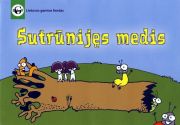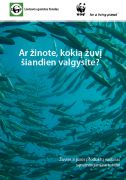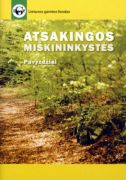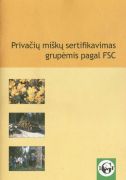The LFN has published various works about ecological education and the protection of nature. They are designated to inform and educate Lithuanian society. The Fund paid most attention to the education of high-school students.
At present the publications that are available for purchase are listed below. If you would like to order some, please call us at +370-5-231-0700 or email us at ingrida.m@glis.lt.

|
Principles of Sustainable Forestry
Danas Augutis and Darius Stončius, published by the Lithuanian Fund for Nature at “UAB Baltijos kopija” in 2011
This is a publication containing information about everything a private forest owner should know about his forest and its sustainable exploitation.
|

|
Dead tree (in Lithuanian)
Lina Augutienė, Darius Stončius, 2008, published by LGF, Baltijos kopija.
Colouring book about importance of dead wood and species living on it. The book is designed for children of 4-8 years. |

|
Biodiversity-friendly Agriculture
Pranas Mierauskas, published by the Lithuanian Fund for Nature at “Petro ofsetas” in 2010
This informational publication provides an overview of biodiversity-friendly farming initiatives, their appearance, and development. Such farming is comparable to ecological farming and application of other agrarian-conservationist measures. The author highlights the fact that unlike other agrarian-conservationist measures, the biodiversity-friendly farming is oriented toward an effective protection of biological diversity. The publication also discusses the practices of biodiversity-friendly farming in foreign countries. It reviews the production of “green” farming items, especially those of meat, and the Swedish experience in this field.
|

|
Do You Know What Fish You Will Eat Today?
Robertas Staponkus and Neringa Pumputytė, published by “Petro ofsetas” in 2010
The brochure will present and inform Lithuania’s consumers about the state of fish resources and will promote responsible consumer skills so that they buy products of sustainable fishery. The guidebook describes the most frequently seen types of marketplace fish, some of their biological properties, dispersal limits, fishing and raising methods, as well as the state of fish resources at present. Also, the guidebook provides information about how to choose fish for everyday consumption in a responsible manner. |

|
Nature Management
Pranas Mierauskas, published by the Lithuanian Fund for Nature at “Gamtotvarkos projektas” in 2009 (260 pp.)
The book presents major wildlife management principles, legal and economic wildlife management aspects, and the management of concrete habitats, species, and ecosystems. The author pays special attention to the protection and management of protected areas and the assessment of the efficacy of wildlife management operations. In the process of writing this work, the author consulted experts with long-term wildlife management experience in Europe, Northern America, and other developed countries; he also used excellent samples from Lithuania. |

|
Forest Diversity: Development, Components, and Processes
Inga Straupe, Martinš Lūkins, Jurga Motiejūnaitė, Giedrius Švitra, and Darius Stončius in 2007
The goal of this work is to demonstrate the natural forest diversity and processes happening within forested areas. The authors want to attract people’s attention to things that most people would not notice. The discussed processes and operations are necessary for a forest, as a natural system, to exist and perform its functions that are also important for human life. |

|
The Living Forest Stream
Lennart Henrikson, Zigmantas Gudžinskas, and Darius Stončius, published by the Lithuanian Fund for Nature at “UAB Baltijos kopija” in 2009
This is a colorful brochure about streams, their fauna and flora, and the latter’s impact on forests. |

|
FSC Chain-of-Custody Certification
Justinas Janulaitis, published by the Lithuanian Fund for Nature at “UAB Baltijos kopija” in 2009
This brochure is meant for wood-processing companies that are deliberating or have already decided to become certified by the FSC. The publication describes the certification procedure, the standard FSC criteria for the chain of production and controlled wood, their implementation, and the use of the FSC trademark.
|

|
Sustainable farming in Coastal laguna areas (in Lithuanian)
dr. Vytautas Gipiškis, Sigitas Juzėnas, Nerijus Zableckis, Mindaugas Survila, Petras Lengvinas, 2008, published by Lietuvos gamtos fondas, Rusnės gamtos fondas.
This informational work provides the practical knowledge gathered about the management of the Uostadvaris meadows and the reconciliation of economic and conservationist interests. |

|
Pond turtles and rare amhibians protection (in Lithuanian)
Dr. Martina Meske, Nerijus Zableckis, Arūnas Pranaitis, Dalia Bastytė, Inga Kondratavičiūtė, 2008, published by Lietuvos gamtos fondas, Leidykla. |

|
Examples of responsible forestry (in Lithuanian)
Darius Stončius, Danas Augutis, 2008, published by LGF, Baltijos kopija. |

|
A Role of Nature Management for the Biodiversity Conservation (in Lithuanian)
Darius Stončius, Rimgaudas Treinys, Pranas Mierauskas, 2001, published by LGF.
The book describes assumptions and necessity for management, preparation of management plans and site management audit. It is meant for environmentalists responsible for the conservation and management of biodiversity in protected areas. This book may be beneficial to those who prepare plans of protected areas, municipal ecologists, specialists of the Ministry of Environment, foresters and those who care for nature protection. |

|
FSC group sertification for privat forest owners (in Lithuanian)
Danas Augutis, 2005, published by LGF, Daigai |

|
Forest diversity: development, elements, processes (in Lithuanian)
Inga Straupe, Martinš Lūkins, Jurga Motiejūnaitė, Giedrius Švitra, Darius Stončius, 2007.
The goal of this work is to demonstrate the natural forest diversity and processes happening within forested areas. The authors want to attract people’s attention to things that most people would not notice. The discussed processes and operations are necessary for a forest, as a natural system, to exist and perform its functions that are also important for human life. |


















